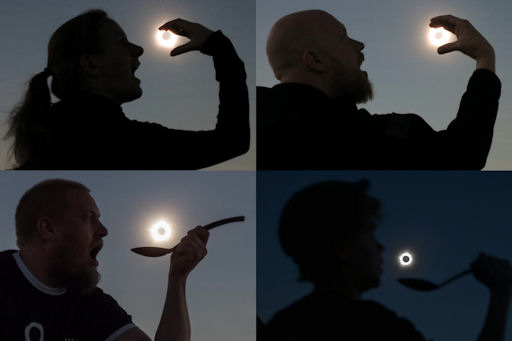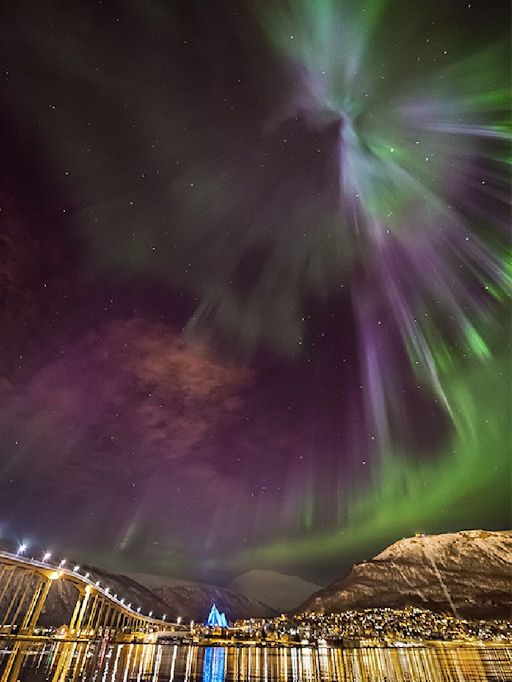CHANCE OF FLARES: NOAA forecasters estimate a 40% chance of M-class solar flares and a 5% chance of X-flares today. The most likely source would be sunspot AR1613, which has an unstable magnetic field. Because AR1613 is directly facing Earth, any eruptions from the active region will almost certainly be geoeffective. Solar flare alerts: text, voice.
SOLAR ECLIPSE FOR BREAKFAST: What do you do when the Moon covers the sun just after sunrise? Have a solar eclipse for breakfast! Janne Pyykkö sends these pictures of people "eating" this week's sunrise total eclipse over Queensland, Australia:

Credits: from top-left to bottom-right are Saul Lehtonen (model Johanna Hoffrén), Johanna Hoffrén (model Saul Lehtonen), Ville Nikula (model Mikael Holappa), Anna Snellman (model Otto Snellman).
"Our Finnish group of 45 eclipse chasers, organized by Tähdet ja avaruus magazine, watched the total solar eclipse on Nov. 14th from the dry desert 150 km north-west of Cairns, Australia," explains Pyykkö. "I coordinated a project to catch photos where people are eating the total solar eclipse; there was no strict guidance about the choice of camera or overall arrangements. Quite a few of us took the challenge. Here is a behind-the-scenes shot that describes the idea."
Browse the photo gallery for more images:
Realtime Eclipse Photo Gallery
GEOMAGNETIC STORM: On Nov. 13th and 14th, Northern Lights spilled across the Canadian border into the United States during a moderately strong (Kp=6) geomagnetic storm. Spotters report naked-eye auroras over Minnesota, Michigan, the Dakotas, Wisconsin, Vermont, Connecticut and, just barely, Colorado and Kansas. The storm, which is subsiding now, flared up as Earth passed through the wake of a CME that swept past our planet on Nov. 13th.
Satellite data show that some of the intense auroral bands were located over Northern Europe. Photographer Ole C. Salomonsen sends this picture from Tromsø, Norway:
"Tonight was a spectacular night," says Salomonsen. "This for sure was the strongest auroras so far this season. The magnetograms at the University of Tromsø went bananas! Tromsø is a city of about 70,000, so it has a lot of light pollution; even so, the auroras were clearly visible standing in the middle of the city. It was just sick!"
"Once a year the Arctic cathedral in Tromsø is lit in blue to put focus on diabetes. This was the first night it was lit blue this year, and man was I lucky to get one of the strongest outbreaks I have ever seen just above it. This was just a mindblowing visual and astronomical experience. I came home with almost 500GB of photos."
More auroras could be in tthe offing. NOAA forecasters estimate a 25% chance of strong geomagnetic storms during the next 24 hours. Aurora alerts: text, voice.

![]()
Solar wind
speed: 426.0 km/sec
density: 1.6 protons/cm3
explanation | more data
Updated: Today at 1617 UT
![]()
X-ray Solar Flares
6-hr max: C3 1254 UT Nov15
24-hr: C6 0437 UT Nov15
explanation | more data
Updated: Today at: 1600 UT
![]()
![]()
![]()
Daily Sun: 15 Nov 12
![]()
![]()
Sunspot AR1613 is crackling with M-class solar flares. Credit: SDO/HMI
![]()
![]()
![]()
Sunspot number: 126
What is the sunspot number?
Updated 14 Nov 2012
Spotless Days
Current Stretch: 0 days
2012 total: 0 days (0%)
2011 total: 2 days (<1%)
2010 total: 51 days (14%)
2009 total: 260 days (71%)
Since 2004: 821 days
Typical Solar Min: 486 days
Update 14 Nov 2012
The Radio Sun
10.7 cm flux: 146 sfu
explanation | more data
Updated 14 Nov 2012
![]()
![]()
![]()
Current Auroral Oval:
![]()
Switch to: Europe, USA, New Zealand, Antarctica
Credit: NOAA/POES
![]()
![]()
![]()
Planetary K-index
Now: Kp= 0 quiet
24-hr max: Kp= 1 quiet
explanation | more data
![]()
Interplanetary Mag. Field
Btotal: 4.2 nT
Bz: 1 nT south
explanation | more data
Updated: Today at 1617 UT
![]()
![]()
![]()
Coronal Holes: 15 Nov 12
![]()
![]()
There are no large coronal holes on the Earthside of the sun. Credit: SDO/AIA.





